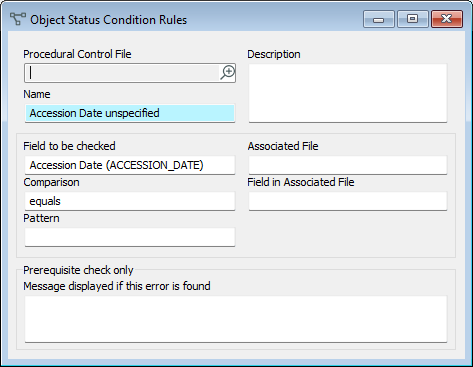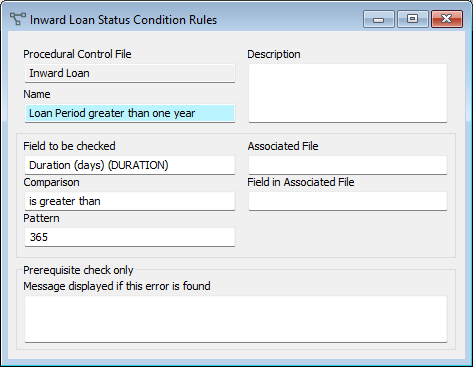Create a rule or action for a procedural status
You can require fields to be entered or tasks to be completed before saving an Object record or Activity record with a Procedural Status term. You can also set messages to appear, require sign-off, and set actions to run.
On this page
Open the Procedural Status term
-
Go to the Database menu and click Other Files.
-
In the Other field, enter status and press Enter on your keyboard.
-
From the list of Procedural Status files, select Object: Procedural Status (or the Activity Procedural Status that you want, such as Outward Loan: Procedural Status) and click OK.
-
With the Procedural Status file window open (for example, the Object: Procedural Status window), click Advanced to open a list of your status records.
- Select the Procedural Status term and click OK.
- Go to the Rules/Actions tab.
Set up a prerequisite condition
You can prevent users from saving a record or warn them if the record does not meet a specific condition. This is a more specific tool than mandatory fields as you can create cataloguing requirements for each Procedural Status.
For example, you can:
-
Prevent a user from saving an Object record as Accessioned if there is no data in the Accession Date field.
-
Warn a user when saving an Object record as Deaccessioned if there is no data in the Deaccession Reason, Method, and Authoriser fields.
-
Prevent a user from saving an Inward Loan record as Proposed without entering start and end dates.
Examples of conditions are shown below.
-
On the Rules/Actions tab, under Prerequisites, click into the Condition to check field.
-
Click Go To to open a new Condition record, then enter the details.
-
In Name, enter a name for the condition.
-
In Field to be checked, enter a field name or click Options to select a field.
-
Enter the Comparison and Pattern.
-
Optional: In Message displayed if this error is found, you can enter a message for the user about why they have been unable to save the record, or to appear as a warning.
-
Click Save and then close the Condition record.
-
-
Next to the Condition to check, in the Effect field, select either Warn or Prevent Save. If nothing is entered, the default effect is to prevent saving.
-
Click Save to save the Procedural Status record.
Example in the Object file
For the Accessioned status, make the Accession Date field required.

-
Name: Accession Date unspecified
-
Field to be checked: Accession Date
-
Comparison: equals
-
Pattern: Leave this field blank.
Example in the Inward Loan file
For the Loan Approved status, warn users if a loan period is greater than one year.

-
Name: Loan Period greater than one year
-
Field to be checked: Duration (days)
-
Comparison: is greater than
-
Pattern: 365
Set up a prerequisite task
You can require tasks to be completed before a record is saved with a procedural status. For example, you might require a photograph of borrowed objects when they arrive at your institution. Users will not be able to save their records at a status until they have scheduled the tasks in the Tasks & Their Costs window.
-
On the Rules/Actions tab, under Prerequisites, click into the Tasks field.
-
Click Options to select a task and click OK.
-
Click Save to save the Procedural Status record.
Set up an action
There is a range of procedural control actions that can be run automatically after an Object or Activity is saved with a new procedural status. For example, opening the Bulk Move tool for all Object records in an Activity record, or sending an email to someone. If you are interested in using actions, or would like one created, contact support@vernonsystems.com.
-
On the Rules/Actions tab, click into the Actions field.
-
Click Options to select an action and click OK.
-
Click Save to save the Procedural Status record.
Schedule a task after saving a record with a status
You can assign tasks when a record is saved. You can specify them in the Tasks To Do field. These tasks are presented to users when they save a record. Users can schedule and document those tasks in the Task & Their Costs window. This is different from prerequisite Tasks, which are enforced.
For example, when an Object record is saved as Accessioned, a user could see the tasks Photograph object and Label object. They can select the tasks they want to schedule (set a date for) and assign to a person.
-
On the Rules/Actions tab, under Actions, click into the Tasks To Do field.
-
Click Options to select a task and click OK.
-
Click Save to save the Procedural Status record.
Create a message
You can write a message that will appear when an Object or Activity record is saved with that procedural status. For example, when an Object record is saved as Accessioned, a message could appear: Remember to label the object with its accession number.
-
On the Rules/Actions tab, click into the Message field.
-
Enter a message to appear when a record is saved with the Procedural Status term.
-
Click Save.
Require sign-off on procedural status changes for all users
You can require a user to sign off with their details and a date for any changes to the Procedural Status field in an Object record or Activity record.
The Actioned by Person and Date Actioned fields may have defaults entered, but these can be overwritten. These details can be viewed along with a history of Procedural Statuses in the Diary window for the record.
Object records
-
Go to the Tools menu > System Maintenance > Customised Configuration.
-
Go to the Objects tab.
-
Under Objects, tick the Enable Sign Off checkbox and the Enforced? checkbox.
-
Click OK.
Activity records
-
Go to the Tools menu > System Maintenance > Activities Configuration.
-
Go to the Sign-Off & Scheduling tab.
-
For any Activity files, tick the Enable Sign Off checkbox and Enforced? checkbox.
-
Click OK.
